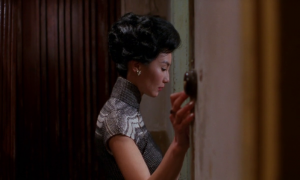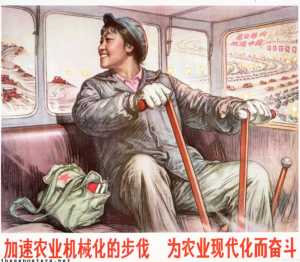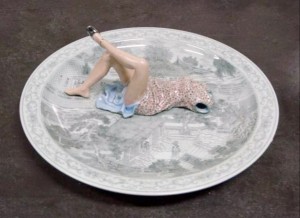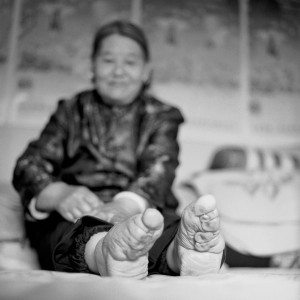
Costume design is not simply for appealing aesthetics and creating a nice fashion; it is more than that. Costume design in film is created to be reflective, representative, symbolic and moving. In “In the Mood For Love,” Maggie’s quipaos are representative and also tell a story to further provide interpretation in what is going on in that point that may not be spoken or blatantly laid out for the viewer to understand. It often requires the viewer to look deeper into the purpose of the design of the costume in order to fully comprehend what is going on in the segment. Maggie’s black and white qipao creates contrasting aromas that indulge the viewer to look closer into Maggie and Tony’s relationship, time, and love.
First off, the contrasting black and white colors in this qipao indicate a sharp contrast in Maggie’s life. The black on her dress could be representative of the sadness she faces when she is suspicious of her husband’s fidelity. This blackness could also be representative of loneliness and sadness; a dark time period in Maggie’s life. The white, however, could be representative of a new, clean slate in which the story is untold. This white part of her dress could be the potential new relationship which she is developing with Tony, and it is a canvas or blank page waiting to be written on. White also represents innocence, where there is a part of Maggie that feels that, although she believes her husband is being unfaithful to her, she feels guilty developing feelings for Tony. The innocence could also be representative of a simple, innocent crush to mend her lonely, broken heart. The sharp contrast with the blackness indicates a shift in feelings where Maggie feels happy and excited by her neighbor, but there is still an underlying sadness that she feels in her heart.
Another important thing to notice is that the black and white lines in the dress do not overlap; they are distinct and separate. These two separate entities could either be representative of Maggie and her husband, Maggie and Tony, or Tony and his wife. However, the divides occur and offer a sense of prediction that the viewer can see that there are distinct things that separate two people, no overlapping is able to occur. It is also important to recognize that certain stripes on the dress are thicker and thinner than others. This could mean that at certain periods in time, one specific entity or person may be more significant in Maggie’s life than the other. This could be representative of her husband, being the dark black stripe in her life, bringing darkness, whereas the white stripe could be representative of Tony, a light in her life. The thickness and thinness indicate that one of the two men play a larger role than the other at distinct times in her life and this is important to note because there is also a sharp contrast between the colors, indicating very contrasting ideals and differences between the two men and how Maggie feels for them both.
nice interpretation of color white and black




